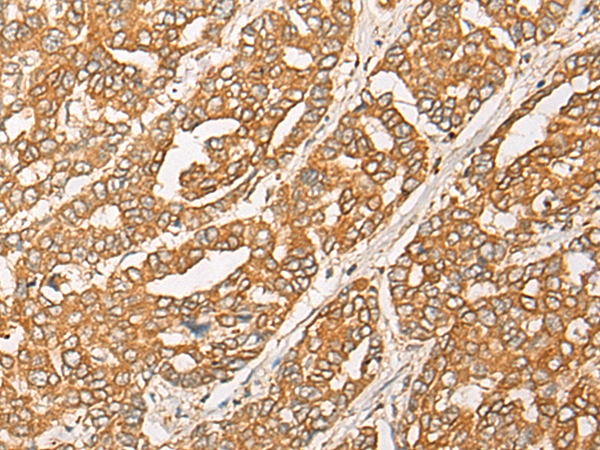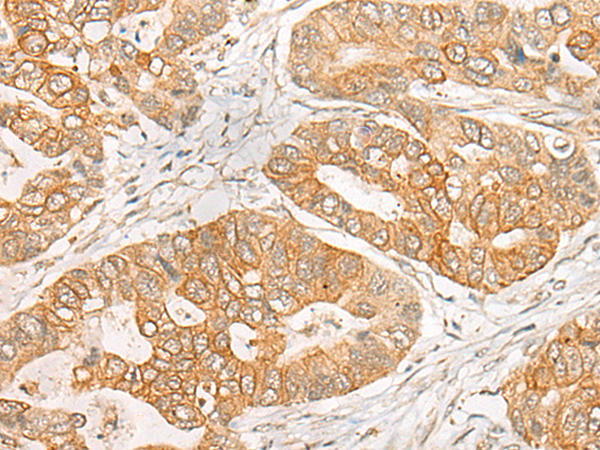

| WB | 咨询技术 | Human,Mouse,Rat |
| IF | 咨询技术 | Human,Mouse,Rat |
| IHC | 1/30-1/150 | Human,Mouse,Rat |
| ICC | 技术咨询 | Human,Mouse,Rat |
| FCM | 咨询技术 | Human,Mouse,Rat |
| Elisa | 1/5000-1/10000 | Human,Mouse,Rat |
| Aliases | GY2; FKSG1; WDR14; WDVCF; DGCRK3 |
| Host/Isotype | Rabbit IgG |
| Antibody Type | Primary antibody |
| Storage | Store at 4°C short term. Aliquot and store at -20°C long term. Avoid freeze/thaw cycles. |
| Species Reactivity | Human, Mouse |
| Immunogen | Synthetic peptide of human GNB1L |
| Formulation | Purified antibody in PBS with 0.05% sodium azide and 50% glycerol. |
+ +
以下是关于GNB1L抗体的3篇代表性文献的简要信息:
1. **文献名称**:*GNB1L, a gene within the 22q11.2 deletion region, is expressed in the developing and adult brain and interacts with Gα proteins*
**作者**:Kato, T., et al.
**摘要**:研究利用GNB1L抗体在大脑组织中进行免疫组化分析,发现GNB1L在胚胎和成年小鼠脑部广泛表达,并参与G蛋白信号通路调控,提示其可能与神经发育异常相关。
2. **文献名称**:*Characterization of GNB1L as a candidate gene for schizophrenia in the 22q11.2 deletion syndrome*
**作者**:Williams, H.J., et al.
**摘要**:通过Western blot和免疫荧光实验(使用GNB1L抗体),发现GNB1L蛋白在患者神经元中表达降低,可能与精神分裂症风险相关,支持其在突触功能中的作用。
3. **文献名称**:*Proteomic analysis of the 22q11.2 region identifies GNB1L as a key interactor in cardiac development*
**作者**:Li, Y., et al.
**摘要**:研究使用GNB1L抗体在小鼠心脏发育模型中检测蛋白表达,发现其与心脏畸形相关,并揭示其通过调控Wnt信号通路影响心脏形态发生。
*注:若需具体文献来源,建议在PubMed或Google Scholar中按标题/作者检索。部分研究可能需结合抗体应用方法(如ChIP、IP)进一步筛选。*
The GNB1L (G Protein Subunit Beta 1 Like) gene, located on chromosome 22q11.2. encodes a protein belonging to the WD-repeat G protein β-subunit family. Though structurally similar to Gβ proteins, GNB1L lacks conserved residues critical for G protein signaling, suggesting divergent functions. It is implicated in 22q11.2 deletion syndrome (DiGeorge syndrome), where haploinsufficiency contributes to congenital heart defects, neurodevelopmental disorders, and psychiatric conditions. GNB1L interacts with chromatin remodelers and transcription factors, influencing neural and cardiac development.
Antibodies targeting GNB1L are primarily used in research to study its expression patterns, subcellular localization, and molecular interactions. They enable detection via techniques like Western blotting, immunohistochemistry (IHC), and immunofluorescence. Studies using these antibodies have revealed GNB1L's nuclear and cytoplasmic distribution, with roles in transcriptional regulation and protein scaffolding. Dysregulation of GNB1L is linked to CHARGE syndrome, autism spectrum disorders, and schizophrenia, highlighting its clinical relevance.
Current research focuses on clarifying GNB1L's mechanistic contributions to developmental pathways and its potential as a biomarker. However, functional insights remain limited, necessitating further exploration of its interactome and post-translational modifications. Commercial GNB1L antibodies vary in specificity; validation using knockout controls is essential to ensure reliability in experimental models.
×